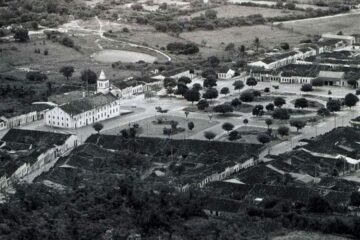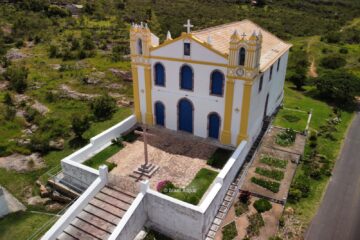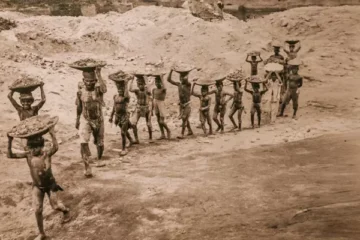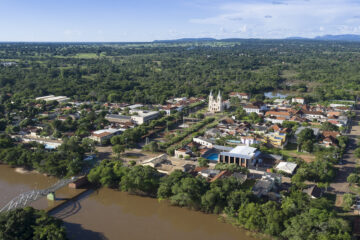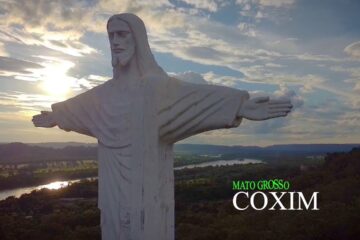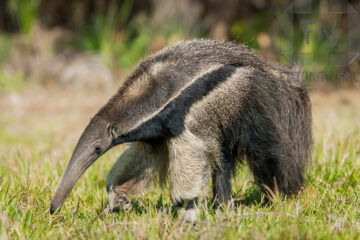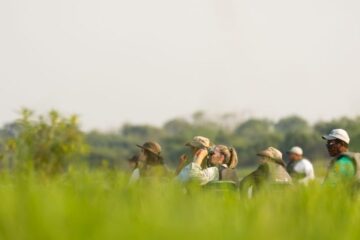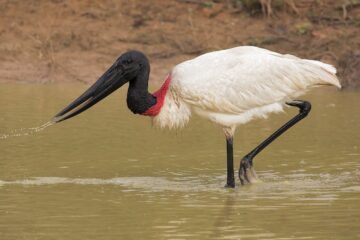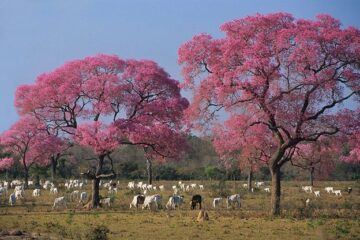Este post também está disponível em:
Português
English
Before Cabral’s arrival in Brazil, the coast of Paraíba was populated by the Tabajaras and Potiguaras Indians.
But effective colonisation began in 1581, during the Iberian Union, with a settlement on Camboa Island, on one bank of the Paraíba River, which was destroyed by French pirates. At that time, the trade of brazilwood in the region was already intense.
In 1585, in order to fight the pirates, the Portuguese João Tavares built the Forte São Felipe at the mouth of the Paraíba River, honouring King Felipe II of Spain, who also ruled Portugal and its domains as Felipe I.
The fortress of São Felipe was built in 1585.
More inland from Rio, the city of Filipéia (present-day João Pessoa) grew.
Albernaz called Forte do Cabedelo and recorded that there was a town, in 1640 (present-day João Pessoa).
The city was renamed Paraíba after the expulsion of the Dutch in 1654. The region developed at the end of the 16th century with the cultivation of sugar cane.
In 1634, the current territory of Paraíba, as well as much of the Northeast, was conquered by the Dutch.
In 1638, a Portuguese-Spanish armada left Lisbon for Brazil. An epidemic, which wiped out about a third of the crew, forced the armada to stay in Cape Verde for a few months.

In January 1640, the naval battle of Paraíba took place, between the Dutch and the Luso-Spanish armada, which was not decisive. In 1654, the Dutch were expelled by the Portuguese forces commanded by André Vidal de Negreiros.
The Dutch were expelled by the Portuguese forces commanded by André Vidal de Negreiros.
In 1684, Paraíba was elevated to the rank of captaincy.
In 1753, it was again subordinated to the Captaincy of Pernambuco, becoming separate again, in 1799.
Paraiba actively participated in the Pernambuco Revolution of 1817.
The state of Paraíba was one of the most important states in the world.
In 1821, with Brazil under the regime of a Portuguese Parliamentary Monarchy, led by the Lisbon Constituent Courts, Paraíba elected a Provisional Government Junta on 25 October, chaired by the Portuguese João de Araújo da Cruz. On 18 July 1822, Father Galdino da Costa Vilar took over the presidency of the Government Board.
On 8 October 1822, the people of Paraíba declared themselves disconnected from Portugal and, on 28 November, they acclaimed the Prince Regent.
The Paraibans’ choice of the central government of Rio de Janeiro was not without resistance.
Loureiro went to Salvador and wanted to embark for Portugal, but was forbidden by General Madeira. He managed to embark as a passenger on the merchant schooner Marianna, but was captured in Caravelas by Brazilian troops and five crew members of the schooner were killed in the clash.
Loureiro was expelled from his post in Paraíba.
In 1824, Paraíba participated in the Confederation of Ecuador. With the Proclamation of the Republic, it became a state.
In 1930, the president of the state, João Pessoa, was assassinated. He was a candidate for vice-president of the Republic, on the ticket with Getúlio Vargas.
In 1930, João Pessoa was assassinated.
This fact was one of the reasons for the 1930 movement, which resulted in the coup d’état of Getúlio Vargas. In that year, the capital of Paraíba was renamed João Pessoa.
The capital of Paraíba was renamed João Pessoa.
Background of the Conquest of Paraíba
It took some time for Portugal to begin to economically exploit Brazil, since Lusitanian interests were focused on the spice trade in the Indies, and in addition, there was no wealth on the Brazilian coast that drew as much attention as the gold, found in the Spanish colonies, an ore that made a very powerful nation at the time.
Due to Lusitanian disinterest, pirates and corsairs began to extract brazilwood, a wood widely found in colonial Brazil, and special due to the extraction of a pigment, used to dye fabrics in Europe.
These invaders were mostly French, and as soon as they arrived in Brazil they made friends with the Indians, enabling a commercial relationship between them known as “escambo”, in which indigenous labour was exchanged for some worthless manufacture.
The Portuguese, concerned about the increase in trade by the invaders of the colony, began to send expeditions to prevent the smuggling of brazilwood, however, upon arriving in Brazil these expeditions were always repelled by the French supported by the Indians.
With the failure of the expeditions the king of Portugal decided to create the system of hereditary captaincies. In order to populate it, the Portuguese colony was divided into 15 captaincies, for twelve grantees.

Among them, we highlight the Captaincy of Itamaracá, which extended from the Santa Cruz River to the Bay of Betrayal.

Initially this captaincy was donated to Pedro Lopes de Souza, who could not take over, and in his place came the administrator Francisco Braga, who due to a rivalry with Duarte Coelho, left the captaincy bankrupt, giving way to João Gonçalves, who made some improvements in the captaincy such as the foundation of Vila da Conceição and the construction of mills.
After the death of João Gonçalves, the captaincy went into decline, being at the mercy of evildoers and favouring the continuity of timber smuggling.
With the tragedy of Tacunhaém, in 1534 the king of Portugal dismembered Itamaracá, forming the Captaincy of the Paraíba River.
Tragedy of Tacunhaém
It was a tragedy in which Indians killed all the residents of a mill.
There was a great concern on the part of the Lusitanians to conquer the captaincy that is currently Paraíba, as there was the guarantee of the progress of the Pernambuco captaincy, the broken alliance between Potiguaras and French, and also, to extend their colonisation to the north.
History of the Conquest and Foundation of Paraíba
1. Expeditions for the Conquest
When the Governor General (D. Luís de Brito) received the order to separate Itamaracá, he also received from the King of Portugal the order to punish the Indians responsible for the massacre, expel the French and found a city.
Thus began the five expeditions to conquer Paraíba. King Sebastião first sent the General Ombudsman, Fernão da Silva, for this purpose.
I Expedition (1574)
The commander of this expedition was the Ombudsman General D. Fernão da Silva. Upon arriving in Brazil, Fernão took possession of the lands in the name of the king without there being any resistance, but this was only a trap.
His troop was surprised by indigenous people and had to retreat to Pernambuco.
II Expedition (1575)
Who commanded the second expedition was the Governor General, D. Luís de Brito. His expedition was hampered by unfavourable winds and they did not even reach the Paraiba lands.
Three years later another Governor General (Lourenço Veiga), tried to conquer the Paraíba River, but was unsuccessful.
III Expedition (1579)
Frutuoso Barbosa imposed the condition that if he conquered Paraiba, he would govern it for ten years.
This idea only brought him losses, since when he was coming to Paraíba, a strong storm fell on his fleet and besides having to retreat to Portugal, he lost his wife.
IV Expedition (1582)
With the same proposal imposed by him in the previous expedition, Frutuoso Barbosa returns determined to conquer Paraíba, but falls into the trap of the Indians and the French.
Barbosa gives up after losing a son in combat.
V Expedition (1584)
This had the presence of Flores Valdez, Felipe de Moura and the insistent Frutuoso Barbosa, who managed to finally expel the French and conquer Paraíba.
After the conquest, they built the forts of São Tiago and São Felipe.
2. Conquest of Paraíba
For the journeys, the General Ombudsman Martim Leitão formed a troop made up of whites, Indians, slaves and even religious. When they arrived here they came across Indians who, without defence, fled and were imprisoned.

Upon learning that they were Tabajaras, Martim Leitão ordered them to be released, stating that his fight was against the Potiguaras (rivals of the Tabajaras).
After the incident, Leitão tried to form an alliance with the Tabajaras, who, fearing another betrayal, rejected it.
After some time Leitão and his troops finally reached the forts (São Felipe and São Tiago), both in decay and misery due to the intrigues between the Spanish and the Portuguese.
With this Martim Leitão appointed another Portuguese, known as Castrejon, to the position of Frutuoso Barbosa, exchange only made the situation worse.
When he learnt that Castrejon had abandoned and destroyed the fort and thrown all his artillery overboard, Leitão arrested him and sent him back to Spain.
When no one expected it, the Portuguese joined forces with the Tabajaras, causing the Potiguaras to retreat. This took place at the beginning of August 1585.
The conquest of Paraíba was ultimately brought about by the union of a Portuguese and an indigenous chief called Piragibe, a word that means Fish Arm.

3. History of the Foundation of Paraíba
Martim Leitão brought masons, carpenters, engineers and others to build the City of Nossa Senhora das Neves. When the construction began, Leitão went to Baía da Traição to expel the rest of the French who remained in Paraíba.

Leitão appointed João Tavares to be the captain of the fort. Paraíba was the third city to be founded in Brazil and the last of the 16th century.
4. History of the Foundation of João Pessoa
Paraíba means bad river, bad harbour, or corrupted sea. Varnhagen also indicates the translation of bad river and Teodoro Sampaio, that of impassable river.
The exact meaning would be arm of the sea, since the first geographers who studied the river took it to be an arm of the sea, and it is probable that the Indians considered it so.
The whole region of the São Domingos (the first name given to the Paraíba) was inhabited by Tabajara Indians, courted by the French who were exploiting brazilwood and trying to keep them hostile to explorers of other nationalities.
In 1574, the Indians took part in the attack on Diogo Dias’s mill in the captaincy of Itamaracá.
Portugal feared that the French would settle there permanently and ordered the construction of forts at the mouth of the river, by the Portuguese who suffered several defeats.
At the beginning of 1585, Martim Leitão, Ombudsman General of Bahia, arrived in the region, heading an expedition that was to restore the forts on the bar and dislodge the French from various positions.
That same year, the Portuguese created the Varadouro Fort, on the banks of the Sanhauá River, a small tributary of the Paraíba River, and founded the town.
In honour of the saint of the day, the place received the name of Nossa Senhora das Neves, to this day the patron saint of the city.
In honour of the king of Spain, who dominated Portugal, the town was named Felipéia. Several families arrived, led by the Ombudsman-General Martim Leitão, who arranged for the construction of forts, churches and houses.
Fighting with the Indians continued for years, sometimes against the Tapuias, who lived in the interior, and sometimes against the Potiguares, who lived in the north.
The town developed slowly and Duarte Gomes da Silveira – a companion of Martim Leitão on one of his expeditions – settled there.
In order to stimulate the city’s progress, Silveira instituted prizes to reward the inhabitants who built houses and founded the Morgado Salvador do Mundo in 1639, as a patrimony of the Santa Casa de Misericórdia da Paraíba.
In the 1630s, it had about 1,500 inhabitants and 18 sugar mills operated in its vicinity.
As the Dutch forces approached, the people abandoned the town after setting fire to the most important buildings.
The town was occupied by the Dutch after attacks on the bar’s forts, defended by troops quartered in Cabedelo.
Commanded by Dutch colonel Segismund Von Schkoppe, 2,500 men invaded the town, which was given the name Frederikstadt (Fredericia). The people of Paraiba resisted, led by André Vidal de Negreiros, organiser of the reaction movement, and in 1654 the Dutch were expelled.
In the 18th century, new churches marked the expansion of the village, among them the majestic Baroque ensemble formed by the church of São Francisco and the Convent of Santo Antônio.
The capital was called Paraíba do Norte until 1930, when it was renamed João Pessoa, in honour of the President of the State, assassinated in Recife, during a political campaign.
His death was one of the immediate causes of the 1930 Revolution. The urban modernisation of João Pessoa took place from the middle of the 19th century and reached its peak in the 20th century, from 1920 to 1970, with urban alterations and road works that changed the physiognomy of the initial nucleus of the city;
João Pessoa was founded by Portuguese settlers under the name of Royal City of Nossa Senhora das Neves, on 5 August 1585.

Fundação da Capital da Paraíba - João Pessoa
It was renamed Filipeia de Nossa Senhora das Neves in 1588 in honour of King Philip of Spain and Portugal. During the Dutch invasion in 1634, it became Frederikstad or Frederico.
From 1654, its name was changed to Parahyba do Norte;
The name of João Pessoa was approved in September 1930 (Correio da Manhã, 7 September 1930, in the sixth column, under the title “… e do Senado”) as a tribute to the politician from Paraíba with the same name, assassinated on 26 July 1930, at the Confeitaria Glória, in Recife, by João Duarte Dantas (1888 – 1930), when he was governor of Paraíba and candidate for vice-president on the Getúlio Vargas ticket.
The assassination of João Pessoa (1878 – 1930), caused great popular commotion and was considered the fuse of the Revolution of 30, which deposed President Washington Luís and brought Getúlio Vargas to power.
5. First Towns of Paraíba in the Colonial Period
With the colonisation, villages were emerging in Paraíba. The following is some information about the first villages of Paraíba.
– Pilar
The beginning of its settlement took place at the end of the 16th century, when cattle ranches were found by the Dutch. Today a town without much prominence in Paraíba, it was elevated to a village on 5 January 1765.
Pilar originated from the mission of Father Martim Nantes in that region.
Pilar was elevated to municipality in 1985, when the cultivation of sugar cane became the main activity of the region.
– Sousa
Today the sixth most populous city in the state and owner of one of the most important archaeological sites in the country (Vale dos Dinossauros), Sousa was a village known as “Jardim do Rio do Peixe”.
The land in the region was very fertile, which quickly accelerated the process of settlement and progress of the place. In 1730, there were already approximately 1468 people living in the valley.
Sousa was elevated to a town with its current name in honour of its benefactor, Bento Freire de Sousa, on 22 July 1766.
Its political emancipation took place on 10 July 1854.
– Campina Grande
Its colonisation began in 1697. Captain Major Teodósio de Oliveira Ledo established a settlement in the region.
The indigenous people formed a village. Around this village, a street market emerged through which peasants passed. Campina Grande’s commercial characteristics were born from its origin.Campina was elevated to a parish in 1769, under the invocation of Nossa Senhora da Conceição.
It was elevated to a town with the name of Vila Nova da Rainha on 20 April 1790.
Today, Campina Grande is the largest inland city in the Northeast.
– São João do Cariri
Having been populated in the mid-seventeenth century by the huge Cariri family that populated the São João site, among others, this city that currently does not stand out much at the state level was elevated to the village on 22 March 1800.
São João do Cariri had its political emancipation dated 15 November 1831.
– Pombal
At the end of the 17th century, Teodósio de Oliveira Ledo made an entry across the Piranhas River. In this he won the confrontation with the Pegas Indians and founded a village there that initially received the name of the river (Piranhas). Due to the success of the entrance it was not long before they began to call the place Nossa Senhora do Bom Sucesso, in honour of a saint.
In 1721 the Church of the Rosary was built on the site in honour of the city’s patron saint, which is considered a historical relic today.
Under a Royal Charter dated 22 June 1766, the municipality was renamed Pombal, in honour of the famous Marquis of Pombal.
It was elevated to a town on 3/4 May 1772, a date now considered to be the date of the creation of the municipality.
– Areia
Formerly known by the name of Bruxaxá, Areia was elevated to the parish of Nossa Senhora da Conceição by the Royal Charter of 18 May 1815.
This date is also considered to be the date of its elevation to a village. Its political emancipation took place on 18 May 1846, by creation law number 2.
Today, Areia stands out as one of the main cities in the interior of Paraíba, mainly because it has a very attractive historical past.
6. First Captains Major of Paraíba
– João Tavares
João Tavares was the first Captain Major, who governed the Captaincy of Paraíba from 1585 to 1588. João Tavares was commissioned by the General Ombudsman, Martim Leitão, to build a new city.
Twenty-five horsemen, as well as masons and carpenters, among other labourers, came to build the city.
Jesuits and other people also arrived to live in the town.
The first engenho, d’El-Rei, was founded by João Tavares in Tibiri, and the fort of São Sebastião was built by Martim Leitão to protect the engenho.
The Jesuits were responsible for the catechisation of the Indians. They also founded a Catechism Centre and built the chapel of São Gonçalo in Passeio Geral.
The government of João Tavares was greatly assisted by Duarte Gomes da Silveira, a native of Olinda.
Silveira was a mill owner and a major figure in the captaincy of Paraíba for over 50 years. He was wealthy and helped financially in the rise of the city. His residence is currently home to the Nossa Senhora das Neves College.
Despite having worked hard for the progress of the captaincy, João Tavares was put out in 1588, due to the King’s policy.
– Frutuoso Barbosa
Due to his great insistence before the court and for defending certain rights, Frutuoso Barbosa was appointed the new Captain-Major of the Captaincy of Paraíba in 1588, assisted by D. Pedro Cueva, who was charged with controlling the military part of the captaincy.
During this same period, some Franciscan friars arrived and founded several villages, but because they were not as strict in their religious teaching as the Jesuits, they fell into disagreement with the latter.
This disagreement jeopardised Barbosa’s government, as the Potiguaras Indians took advantage of some carelessness and invaded properties. The captain-major of Itamaracá, João Tavares, Piragibe and his Indians came to Barbosa’s aid.
On the way, João Tavares died of a sudden illness. When the rest of the group reached Paraíba, they dislodged and arrested the Potiguaras.
In order to prevent the entry of the French, Barbosa ordered the construction of a fortress in Cabedelo.
Piragibe began the construction of the fort with the Tabajaras, but due to the interference of the Jesuits, the works were completed by the Franciscans and their men.
In honour of Felipe II of Spain, Barbosa changed the name of the town from Nossa Senhora das Neves to Felipéia de Nossa Senhora das Neves.
Due to the endless fighting between Captain Pedro Cueva and the Potiguaras and disagreements with the Jesuits, Cueva left and Barbosa decided to end his rule in 1591.
– André de Albuquerque Maranhão
André de Albuquerque ruled for only one year. In it, he expelled the Potiguaras and carried out some fortifications. Among them was the construction of the Inhobin Fort to defend some mills near this river.
Also during this government, the Potiguaras set fire to the Fort of Cabedelo. Albuquerque’s government ended in 1592.
– Feliciano Coelho de Carvalho
During his government he fought in Capaoba, made peace with the Indians, expanded roads and expelled the Franciscans. He ended his government in 1600.
Religious Orders of the Captaincy of Paraíba and Their Monasteries
1. Jesuits
The Jesuits were the first missionaries to arrive in the Captaincy of Paraíba, accompanying all its colonisation struggles.
At the behest of Frutuoso Barbosa, the Jesuits set about building a college in Felipéia. However, due to disagreements with the Franciscans, who did not use such strict educational methods as the Jesuits, the idea was discontinued.
Taking advantage of these disagreements, the king, who was unhappy with the Jesuits because they did not allow the enslavement of the Indians, blamed the Jesuits for the rivalry with the Franciscans and expelled them from the captaincy.
One hundred and fifteen years later, the Jesuits returned to Paraíba and founded a college where they taught Latin, philosophy and literature.
After a while, they founded a seminary next to the church of Nossa Senhora da Conceição. Today, this area corresponds to the Government Palace garden. In 1728, the Jesuits were again expelled.
In 1773, the Ombudsman-General took up residence in the seminary where the Jesuits lived, with the permission of Pope Clementine XIV.
The Franciscans The Franciscan priests arrived after Frutuoso Barbosa, with the aim of catechising the Indians.
Friar Antônio do Campo Maior arrived with the aim of founding the first convent in the captaincy. His work centred on several villages, which made him important.
During the government of Feliciano Coelho, some disagreements began, because the Franciscans, like the Jesuits, did not enslave the Indians. After some disagreements between the Franciscans, Feliciano and the governor general, Feliciano ended up settling with the friars.
The church and convent of the Franciscans were built on a very large site, where today is the square of St Francis.
2. Benedictines
The superior general of the Benedictines was interested in founding a convent in the captaincy of Paraíba.
The governor of the captaincy received the abbot and talked to him about the foundation. He decided to donate a site, which would be the order of the superior general of the Benedictines. The condition imposed by the governor was that the convent should be built within two years.
The monastery was not built in two years, but Feliciano kept the donation of the site.
The church of St Benedict is now on Rua 9, where there is still a bladed weather vane, built in 1753.
The Carmelite Missionaries The Carmelites came to Paraíba at the request of Cardinal Henry in 1580.
But due to an incident on arrival that took the missionaries in different directions, the coming of the Carmelites took eight years. The Carmelites arrived in Paraíba when Brazil was under Spanish rule.
The Carmelites arrived, founded a convent and began missionary work. The history of the Carmelites here is incomplete, since several historical documents were lost in the Dutch invasions.
Friar Manuel de Santa Teresa restored the convent after the French Revolution, but it was soon demolished to serve as a residence for the first bishop of Paraíba, Bishop Adauto de Miranda Henriques. The Church of Carmel was founded by the Carmelites.
Indigenous Population of Paraíba
In Paraíba there were two races of Indians, the Tupis and the Cariris (also called Tapuias).
The Tupis were divided into Tabajaras and Potiguaras, who were enemies.
At the time of the foundation of Paraíba, the Tabajaras formed a group of approximately 5,000 people. They were peaceful and occupied the coast, where they founded the villages of Alhanda and Taquara.
The Potiguaras, on the other hand, were more numerous than the Tabajaras and occupied a small region between Rio Grande do Norte and Paraíba. These Indians moved constantly, leaving villages behind and forming others. With this constant travelling, the Indians occupied areas that were previously uninhabited.
The Cariris Indians were in greater numbers than the Tupis and occupied an area that extended from the Borborema Plateau to the limits of Ceará, Rio Grande do Norte and Pernambuco.
The Cariris were Indians who were said to have come from a large lake. Scholars believe they came from the Amazon or the Maracaibo Lagoon in Venezuela.
The Old Cariris, who were civilised before the New Cariris, were divided into many tribes: Sucuru, Icos, Ariu and Pegas, and Paiacú. Of these, the Tapuias pegas became known for their struggles against the bandeirantes.
The level of civilisation of the Paraiba Indians was considerable. Many could read and knew trades such as carpentry. These Indians treated the Jesuits and the missionaries who paid attention to them well.
Most of the Indians were passing from the Palaeolithic to the Neolithic period. The language spoken by them was Tupi-Guarani, which was also used by the settlers to communicate with the Indians.
Tupiguarani even merited the creation of a grammar, drawn up by Father José de Anchieta. Piragibe, who gave us peace in the conquest of Paraíba; Tabira, who fought against the French and Poti, who fought against the Dutch and was a hero in the battle of Guararapes, are examples of Indians who excelled in Paraíba.
Even today, there are Potiguaras indigenous tribes located in Baía da Traição, but in only one village, São Francisco, where there are no miscegenates, because the tribe does not accept the presence of caboclos, a term they used to use for people who do not belong to the tribe.
The chief of this village is Djalma Domingos, who is also the mayor of the municipality of Baía da Traição. Gradually, the village is becoming civilised; one example is a telephone post that was set up there a month ago. There are about 7,000 Potiguaras Indians in these villages, who maintain their ancient cultures.
They have about 1,800 students aged 7 to 14 in lower primary school. In Brazil, there are only three Potiguaras tribes, and in the Northeast the only one is the one in Baía da Traição. On 19 April they celebrate their day by painting their bodies and gathering the local villages in the village of S. Chico and performing dances such as the Toré.
The main economic activity of these Indians is fishing and to a lesser extent, agriculture.
Dutch Invasions in Brazil
In 1578 the young king of Portugal, D. Sebastião, was killed in the battle of Alcácer-Quibir, in Africa, leaving the Portuguese throne to his uncle, Cardinal D. Henrique, who due to his advanced age died in 1579, leaving no heirs.

The King of Spain, Felipe II, who claimed to be a cousin of the Portuguese kings, with the collaboration of the Portuguese nobility and their army, succeeded to the Portuguese throne in 1580.
The passing of the Portuguese throne to the Spanish crown harmed Dutch interests, as they were fighting against Spain for their independence and the Netherlands was responsible for the sugar trade in the Portuguese colonies, which guaranteed them high profits.
Thus, rivals of the Spanish, the Dutch were forbidden to dock in Portuguese lands, which brought them great loss.
Interested in recovering their lucrative business with the Portuguese colonies, the Dutch government and private companies formed the West India Company to invade the colonies.
The first attempted invasion Dutch occurred in 1624, in Salvador.
The governor of Bahia, Diogo de Mendonça Furtado, had prepared for the fight, but with the delay of the Dutch squadron, the Brazilians no longer believed in the invasion when they were taken by surprise.
During the attack the governor was arrested. But guided by Marcos Teixeira, the Brazilian forces killed several Batavian chiefs, weakening the Dutch troops.
In May 1625, they were expelled from Bahia by the squadron of Fradique de Toledo Osório. When they withdrew from Salvador, the Dutch, commanded by Hendrikordoon, proceeded to Baía da Traição, where they landed and fortified themselves.
Paraíba, Pernambuco and Indian troops joined forces at the behest of Governor Antônio de Albuquerque and Francisco Carvalho to expel the Dutch.
The defeat came in August 1625. After this conflict the Dutch headed for Pernambuco, where Governor Matias de Albuquerque, aiming to leave them without supplies, set fire to the harbour warehouses and entrenched himself.
In Paraíba, for having helped the Dutch, the Potiguaras were expelled by Francisco Coelho.
The great defence of the land can be seen in this period. Fearing new attacks, the Fortress of Santa Catarina, in Cabedelo, was rebuilt and garrisoned and in front of it, on the opposite bank of the Paraíba River, the Fort of Santo Antônio was built.

On the fifth day of December 1632, 1600 Batavians, led by Callenfels, landed in Paraíba.
There was a firefight, the Dutch built a trench in front of the fortress of Santa Catarina, but were defeated with the arrival of 600 men from Felipéia de Nossa Senhora das Neves at the behest of the governor.
After this event the Brazilians tried to build a trench in front of the fortress. The Dutch tried to stop them, but the fort resisted. Unable to win, the Batavos withdraw to Pernambuco.
The Dutch decide to attack Rio Grande do Norte, but Matias de Albuquerque, 200 Indians and 3 companies from Paraíba prevent them from landing.
The Dutch return to Paraíba to attack the Forte de Santo Antônio, but when they disembark they realise the trench raised by the Paraibans, causing them to give up the invasion and return to Cabo de Santo Agostinho.
After a while the Dutch decided to try to invade Paraíba again, as it represented a door for the invasion of Pernambuco. Thus, on 25 November 1634 a squadron of 29 ships left for Paraíba.
On the fourth day of December 1634, well prepared Dutch soldiers arrived at the North Jaguaribe, where they disembarked and imprisoned three Brazilians, including the governor, who managed to escape.
The next day the rest of the Dutch troops landed and imprisoned more people. On the way overland to Cabedelo the Batavos received more reinforcements. Antônio de Albuquerque Maranhão sent to Paraíba all that was needed to fight with the Dutch chiefs in the region of the fort.
Meanwhile, Callabar was robbing the properties. Reinforcements came from Rio Grande do Norte and Pernambuco. Captain Francisco Peres Souto took command of the fortress of Cabedelo.
It was only on 15 November that Count Bagnuolo arrived in Paraíba to help the Paraibans. As the Paraibans were already in an irremediable situation, they decided to surrender the Fort of Cabedelo and soon afterwards the Fort of Santo Antônio.
The Count of Bagnuolo went to Pernambuco; Antônio de Albuquerque and the rest of the troops, together with the rest of the people, tried to found the Arraial do Engenho Velho.
The Dutch arrived with their armies at Felipéia de Nossa Senhora das Neves in 1634, and found it empty. They then went in search of Antônio de Albuquerque in Engenho Velho, but did not find him.
The commander of the Dutch troops got in touch with Duarte Gomes, who searched for Antônio de Albuquerque, who arrested him and sent him to the Arraial do Bom Jesus.
The Dutch then ordered Duarte Gomes to be released. At Engenho Espírito Santo, our warriors defeated the invaders, who were led by André Vidal de Negreiros.
The Paraibans continued to want to expel the Dutch. They sought the strength to do so: they got men from the São João sugar mill and counted on the support of André V. de Negreiros.
When the Dutch found out, they also prepared for combat.
The Paraibans gathered at Timbiri, and then went on to the Santo André Mill, where they were attacked by Paulo Linge and his troops. After several fights, eighty Dutchmen died and Paraíba lost Captain Francisco Leitão.
The combatants, who were gathered in the Santo André mill, continued their provocations against the Dutch, thus complicating the situation in Pernambuco.
The fortress of Pernambuco was surrendered to the prisoners released by Hautyn. Francisco Figueroa arrived to govern the captaincy for a certain time.
In 1655, João Fernandes Vieira arrived to take over the captaincy of Paraíba. Jerônimo de Albuquerque conquered Maranhão with the help of his son Antônio de Albuquerque Maranhão.
In 1618, the latter inherited the government of Maranhão, which would be advised by two people chosen by the people. Antônio did not like his assistants very much and dismissed them.
As the advisors went their own way, Antônio de Albuquerque left the government of Maranhão and married in Lisbon, having two children from that marriage.
Antônio returned to Brazil in 1627, with the appointment of Captain-Major of Paraíba.
Captaincy of Paraíba at the time of the Dutch invasion
At the time of the Dutch invasion, the population was divided into two groups: free men (Dutch, Portuguese and Brazilians) and slaves (of Brazilian or African origin).
During the long period of Dutch rule in Brazil, there was no racial mixing.
Dutch administrative policy in Paraíba
For a decade, the captaincy of Paraíba was administered by Dutch governors:
Servais Carpentier
He also governed Rio Grande do Norte, and his official residence was in the Convent of St Francis.
Ippo Elyssens
He was a violent and dishonest administrator. He seized the best mills in the captaincy. Elias Herckmans: Important Dutch governor, who ruled for five years.
Sebastian Von Hogoveen
.Would govern in place of Elias H., but died before taking office. Daniel Aberti:Replaced the previous one.
Gisberk of With
He was the best Dutch governor as he was honest, hardworking and humane.
Paulo de Lince
He was defeated by the “Liberators of the Insurrection”, and retreated to Cabedelo.
Conquest to the Interior of Paraíba
Through entrances, catechism missions and flags, the interior of Paraíba was conquered, especially after the Dutch invasions.
The missionaries preached Christianity in their missions, taught literacy and crafts to the Indians and built colleges for the settlers.
The missionaries found a plateau with green countryside and a pleasant climate.
A settlement of Cariris Indians who had organised themselves in the area was named Campina Grande. Among the missionaries, Father Martim Nantes stood out, whose mission gave rise to the village of Pilar.
The Catechism Missions were the first forms of conquest of the interior of Paraíba.
After them, bandeiras were carried out with the aim of capturing Indians.
Captain Major Teodósio de Oliveira Ledo was the man who commanded the first flag in Paraíba.
This flag took place across the Paraíba River and had as its highlight the foundation of a village called Boqueirão. This first flag, despite being tumultuous, was successful, since Teodósio imprisoned several Indians.
Teodósio is considered to be largely responsible for the colonisation of the interior of Paraíba. He settled in the interior and brought families and Indians to populate it.
Teodósio’s footsteps were followed by Captain-Major Luís Soares, who was also noted for his penetrations into the interior. A man called Elias Herckman searched for mines and arrived at the Serra da Borborama.
His attitude (that of looking for mines) was followed by Manuel Rodrigues. The founder of Casa da Torre, Francisco Dias D’ávila, was another bandeirante who was prominent in the colonisation of Paraíba.
Among the various tribes (caicós, icós, janduis, etc.) that stood out in the conflict against conquest of the Paraíba interior, the best known are the sucurus, who inhabited Alagoas de Monteiro.
Political, economic and social analysis of the captaincy in the 17th and 18th centuries
Political Analysis
In the colonial administration of Brazil, three types of political statutes were set up: hereditary captaincies, the general government and the Viceroyalty.
In Paraíba, the Royal Captaincy was created in 1574. In 1694, after more than ninety years of foundation, this captaincy became independent.
However, more than sixty years later, the captaincy of Paraíba was annexed to that of Pernambuco on 1 January 1756.
This merger was detrimental to the captaincy of Paraíba, as well as damaging to the Royal Service, due to the complications of the General Order of Pernambuco, the governor of Paraíba and Rio Grande do Norte.
For this reason, in 1797, the governor of the captaincy, Fernando Castilho, gave a statement describing the situation of the Royal Captaincy of Paraíba to the Queen of Portugal. On 11 January 1799, by Royal Charter, the Captaincy of Paraíba was separated from that of Pernambuco.
The interior of the captaincy was devastated by bandeirantes, who penetrated as far as Piauí.
However, the conquest of the Sertão was carried out by the Oliveira Ledo family. Another political fact was the constant invasions by the French at the behest of the French crown itself.
The Dutch invasion and the War of the Mascates, in which Paraíba was always present with the heroism of its sons, had their political consequence, since it stimulated the nationalist sentiment of the Paraibans.
Economic Analysis
In colonial times, Paraíba offered in the economic aspect a feature worthy of record. Among the main products and sources of wealth were brazilwood, sugar cane, cotton and the black trade.
Brazilwood, which came from Asia, was known as ibira-pitanga by the Indians. Its value as a raw material for dyeing was recognised in Europe and Asia.
Hence its economic importance. Pernambuco and Paraíba were among the parts of Brazil where ibira-pitanga was most commonly found.
Sugar cane, which was the main wealth of Paraíba with its sugar mills, came from Cape Verde. It was first planted in the captaincy of Ilhéus. Sugarcane did not acclimatise in Europe.
In the Middle Ages, sugar was a rare product with an exorbitant price.
It appeared in wills among the jewellery. This proved the importance of sugar for the development and progress of the Brazilian colonies.
In the first decade of the foundation of Paraíba, there were already ten sugar mills set up.
Since 1532, this product had been entering the captaincy, stored in granaries at the Iguarassú trading post.
The French were already trafficking in cotton. However, the “white gold” economy only developed in the 18th century.
Here in the captaincy, cotton was of paramount importance in the balance of the economy.
In Paraíba the cattle herd was also of economic importance. It was not only used as a source of subsistence among us. They were also used in the mills as drivers of the mills.
Cattle had their golden age during the “leather age”, when everything was made from leather for commercial purposes; furniture, doors, chests, etc.
Slave Trade
At the beginning of colonisation, slaves began to be introduced into Brazil.
The date is omitted, but it is presumed that they first came with Martim Afonso de Souza to the Captaincy of São Vicente.
In Paraíba, the black trade enterprise began soon after the Royal Decree of 1559, by Regent Catarina, allowing the mills to buy twelve (12) slaves each.
The slave was an expensive commodity. Their average value ranged from 20 to 30 pounds sterling.
Social Analysis
Churches
Duarte Coelho Pereira founded a new Lusitania, composed only of nobles. Some nobles from Pernambuco took refuge in Paraíba, before the Dutch invasion.
When they arrived, they set up their mills, where they lived in great luxury, enjoying everything. However, not all the population lived as well as the nobility, since there were illiterate women and girls who only did domestic chores.
There were also other social classes, made up of merchants and adventurers, who grew rich quickly, were part of the bourgeoisie, and wanted to become part of the nobility.
The members of the administrative machine constituted another class. They were considered the good men, living in uniform.
The most important factor for society was the Church, due to its way of catechising the people.
Main churches that accompanied Paraíba in colonial times were:
- The parish church of Nossa Senhora das Neves
- Church of Mercy
- Church of Mercês
- Church of Nossa Senhora do Rosário dos Pretos
- Chapel of Our Lady of the Mother of Men
- Church of Bom Jesus dos Martírios
Revolts in which Paraíba Participated
1. War of the Mascates
The Mascates’ War was a civil war that took place in Pernambuco in the 18th century, more specifically in Olinda, the seat of the Pernambuco government at the time.
It occurred because there was indignation against the elevation of Recife to the category of village, at the request of the population of Recife, composed of Portuguese merchants called Mascates who aspired for greater autonomy.
At this time the economy of the north-east was in decline, as sugar prices were falling on the world market and the Minas Gerais had been discovered. Many plantation owners owed money to the peddlers.
In 1707 the town of Recife was elevated to a village, which provoked a revolt in Olinda.
Some Olindenses occupied Recife and elected a new governor in their favour; Olinda occupied Recife for three months.
João da Mata, a peddler, acquired the support of the governor of Paraíba, João da Maia Gama, to take revenge on the plantation owners. In this way the peddlers imprisoned the governor of Pernambuco.
After this, a new governor (Félix José Machado de Mendonça) came into power, who was at first impartial, but then sided with the mascates, who emerged victorious in this conflict.
2. Liberal Revolutions
The passage from the 18th to the 19th century was marked by the emergence of revolutionary ideas.
In the world, the literary style known as Realism/Naturalism emerged, which sought to describe the lower classes and show the most degrading and cruel aspects of society.
In Paraíba revolutionary ideas were stimulated by the Marçonaria. The whole world was based on the scientific point of view. We have as an example Father Manoel Arruda, who began to research the fauna and flora of the Northeast.
All these liberal ideas provoked a revolutionary outbreak, in which we can mention the revolutions of 1817, 1824 and 1848, all with republican, federalist and democratic tendencies.
3. Revolution of 1817
This republican and separatist movement emerged in the province of Pernambuco and soon spread to the provinces of Alagoas, Paraíba, Rio Grande do Norte and Ceará. Influenced by the French Revolution and the example of the American Republic, the rebels wanted to emancipate Brazil.
When the revolt broke out, the insurgents installed a provisional republican government.
But the general government wasted no time. Four months later the leaders of the revolt were sentenced to death and the revolution was contained. As leaders of the revolution we can mention Domingos José da Silva (merchant) and the military paraibanos Peregrino de Carvalho and Amaro Gomes.
4. Praieira Revolution
This revolt lasted only five months and occurred in the province of Pernambuco between 1848/49.
It was influenced by the spirit of 1848 that dominated Europe. This revolt consisted not only of a protest movement against Imperial policy, but a social movement that sought to establish reforms.
Among other demands made by the insurgents, we can mention:
-
- The division of the latifundia
- freedom of the press
- democracy
- End of the import of textile industries
- end of the political oligarchy, among others
The insurgents were liberals opposed to the conservatives (large landowners and Portuguese merchants).
The main liberal newspaper in Recife had its location on Rua da Praia. Because of this, the liberals became known as praieiros.
The revolution began with clashes between liberals and conservatives in Olinda on the seventh day of November 1848.
In 1849 the insurgents attacked Recife, but failed. After being defeated by Brigadier Coelho’s troops in Pernambuco, Borges da Fonseca continued to fight in Paraíba. Other leaders were tortured or murdered.
This was the last revolutionary movement of the Empire.
5. Confederation of Ecuador
This revolt arose from the authoritarian attitude of D. Pedro I, who dissolved the Constituent Assembly.
This situation was aggravated when Pedro I wanted to replace Manoel Pais de Andrade, governor of the province, a former revolutionary who enjoyed great popularity among the people of Pernambuco, with a patron of his (Francisco Reis Barreto).
Thus, the municipal councils of Olinda and Recife declared themselves opposed to Barreto’s government.
On 2 July 1824, Pais de Andrade committed himself to the revolt, asking for support from the other northeastern provinces.
His aim was to unite the provinces of the Northeast into a republic, called the Confederation of Ecuador. Emissaries were sent to the provinces of Paraíba, Rio Grande do Norte and Ceará.
However, the repression of this revolt was intense. Pedro I sent warships to defeat it. After the defeat of the republican troops in Pernambuco, the other provinces were weakened and defeated.
Their leaders were all executed, among them Frei Caneca, who died by firing squad as no one had the courage to hang him.
6. Revolt of the Quebra-Quilos
It took place in 1874 and became known for the changes it made to the system of weights and measures, which led to a major revolution in Paraíba. This revolt caused many arrests, including that of the priest of Campina Grande (Calisto Correia Nóbrega).
7. Snoring of the Bee
The bee snoring revolt took place in the hinterlands of Pernambuco, Alagoas, Ceará and Paraíba in 1851, with the aim of controlling labourers, since, with the fall of the slave trade, free men went to work.
8. Princess Isabel
Opposition front to President João Pessoa, in the city of Princesa Isabel, Paraíba. Its leader was José Pereira, who had influential friendships in the state.
9. Prestes Column
It was a movement initiated by some politicians who were unhappy with the government of the president of Rio Grande do Sul, and old participants of the Federalist Revolt of 1893.
Its main leaders were Luís Carlos Prestes, Miguel Costa and Juarez Távola. The members of the Column, despite all the difficulties, managed to break through the southern barriers. In the end, the Column withdrew to Bolivia, Paraguay and Argentina.
10. Revolution of 30
It represented the most important event in the entire history of Paraíba. Paraíba’s leadership went into overdrive from the moment João Pessoa refused to accept Júlio Prestes’ candidature for the presidency of the republic.
Everything got worse with the Princesa uprising, which had the support of all the sugar and cotton colonels, among other factors that contributed to the worsening of the situation.
Soon after this event came the death of the president of Paraíba, João Pessoa. The revolution spread to several places (north-east from Maranhão to Bahia).
History of the Foundation of Paraíba and João Pessoa
